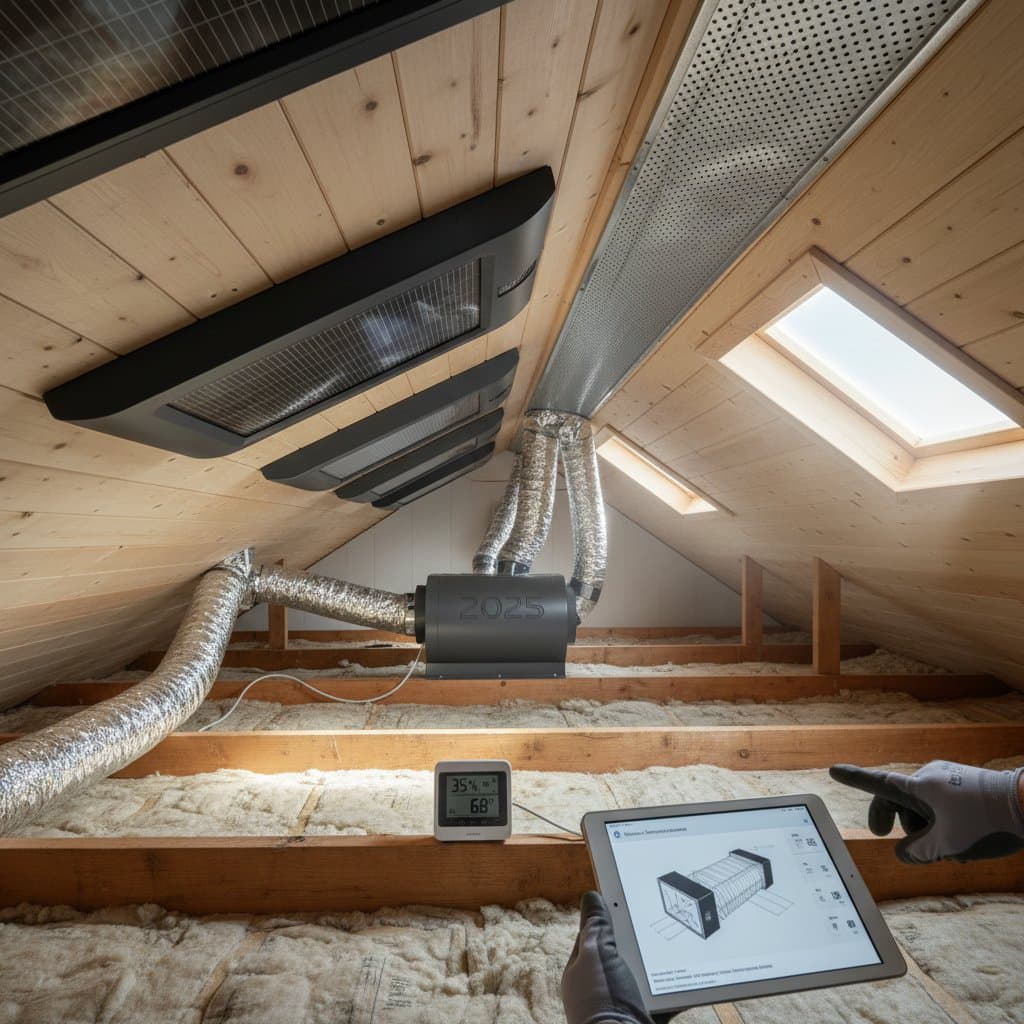2025 Attic Mold Costs: Prevention Delivers Major Savings
Mold growth in the attic represents a concealed hazard that undermines a home's structural integrity, indoor air quality, and market value. Homeowners frequently overlook the rapid proliferation of mold in attics with inadequate ventilation or excess humidity. By the point when stains emerge on rafters or insulation, remediation demands significant expense and inconvenience. Grasping the elements that influence attic mold costs, effective prevention methods, and appropriate professional involvement safeguards both property and finances.
Primary Causes of Attic Mold
Attic mold emerges when moisture contacts organic surfaces such as wood or insulation materials. Typical moisture origins encompass:
- Inadequate ventilation that confines warm, humid air
- Leaks from roofs at flashing points, vents, or shingles
- Exhaust fans from bathrooms or kitchens discharging into the attic rather than outdoors
- Condensation arising from discrepancies in heating and cooling systems
- Insufficient insulation leading to temperature fluctuations
Persistent exposure to these conditions provides ideal environments for mold spores. Home inspectors often note that attic mold typically stems from systemic deficiencies in insulation, airflow, and moisture regulation, rather than isolated roof failures.
Actual Expenses of Attic Mold Remediation
Remediation costs for attic mold fluctuate based on the infestation's extent, mold variety, and attic accessibility. Minor, contained instances may resolve for a few hundred dollars, whereas extensive cases requiring structural fixes or insulation renewal can escalate to thousands.
Specialized firms generally bill per square foot, factoring in containment and decontamination complexity. Standard components include:
- Inspection and testing: Thorough evaluations with laboratory analysis to identify spore types
- Containment measures: Installation of plastic barriers, negative air systems, and safeguards against spore dissemination
- Mold eradication: Scrubbing, HEPA vacuuming, and application of antimicrobial agents
- Material renewal: Disposal and substitution of affected insulation or drywall
- Moisture remediation: Corrections to leaks, ventilation enhancements, or insulation modifications
Omitting any phase risks mold recurrence and heightened future expenditures.
Advantages of Prevention Over Remediation
Attic mold prevention incurs far lower costs than remediation efforts. Routine upkeep and targeted improvements avert thousands in damages. Strategies emphasize moisture limitation and ventilation optimization.
Essential prevention actions:
-
Ventilation system optimization
Ensure steady airflow from soffit vents to ridge or gable vents, expelling humid air prior to surface condensation. -
Roof and flashing upkeep
Conduct biannual roof examinations for absent shingles, compromised flashing, or deteriorated caulking near vents. Minor leaks frequently initiate undetected mold development. -
Insulation uniformity
Uneven insulation generates cold zones prone to condensation. Uniform application stabilizes temperatures and curbs moisture accumulation. -
Exhaust fan redirection
Route bathroom and kitchen fans to exterior outlets via roof or wall penetrations, avoiding attic humidity influx. This adjustment ranks among the easiest preventive steps. -
Humidity level oversight
Employ a hygrometer to monitor attic humidity. Levels under 50 percent substantially diminish mold proliferation risks.
Homeowners who enhance ventilation and seal air pathways often reduce anticipated mold expenses by up to 80 percent, forestalling the need for comprehensive treatments.
DIY Approaches Versus Professional Services
Certain homeowners opt for self-managed mold removal in minor cases. For superficial mold on reachable wood surfaces, safe execution involves protective equipment, detergent scrubbing, and mold-inhibiting sealants to halt progression.
Professionals become essential in scenarios such as:
- Infestations exceeding 10 square feet
- Attics with restricted entry or confined spaces
- Unidentified moisture origins
- Households with allergy or respiratory sensitivities
- Presence of black mold or pronounced discoloration
Experts not only eradicate mold but also diagnose root causes. They deploy HEPA filters, containment protocols, and potent cleaners to prevent spore migration. Services often include documentation and guarantees, beneficial for property transactions.
Factors Elevating Remediation Prices
Elevated costs frequently arise from unaddressed complications that exacerbate damage. Key influencers include:
- Structural impairments: Mold infiltration into rafters or sheathing necessitates wood framing replacements.
- Insulation disposal: Affected materials require complete removal and substitution.
- Access challenges: Confined or steeply pitched attics intensify labor demands.
- Moisture origin fixes: Roof repairs, vent installations, or fan corrections incorporate additional labor and supplies.
- Verification testing: Post-treatment air assessments confirm safety but incur fees.
Homeowners who neglect ventilation often encounter recurring issues, where initial cleanups cost thousands yet return promptly without corrections.
Consequences of Postponement
Delaying attic mold intervention proves financially detrimental. Extended moisture exposure allows mold to infiltrate deeply into wood, insulation, and drywall, compromising structural elements and air quality.
Beyond cleanup, delays lead to diminished energy efficiency from compromised insulation, resulting in elevated utility bills alongside remediation outlays. Early intervention preserves both costs and home performance.
Health Implications
Attic mold spores can infiltrate living spaces via vents or ceiling fissures. Vulnerable individuals might suffer coughing, headaches, or allergic responses. Prolonged contact aggravates respiratory ailments.
Certified remediation adheres to protocols from bodies like the Institute of Inspection Cleaning and Restoration Certification, containing and eliminating spores to restore safe environments.
Cost Comparisons Across Scenarios
The following table outlines typical expenses based on infestation severity:
| Situation | Estimated Cost Range | Common Causes | Recommended Solution |
|---|---|---|---|
| Minor surface mold on rafters | $200–$500 | Slight condensation | DIY scrubbing and sealing |
| Moderate spread in corners or insulation | $500–$2,000 | Inadequate ventilation or leaks | Professional decontamination and airflow upgrades |
| Extensive mold with odors or stains | $2,000–$5,000 | Ongoing leaks or venting faults | Comprehensive remediation and material renewal |
| Structural harm or black mold | $5,000+ | Chronic moisture | Expert remediation with repairs |
Biannual attic inspections enable avoidance of severe, costly outcomes through basic maintenance.
Sustained Prevention Tactics
Post-remediation, ongoing dryness demands vigilance over ventilation, insulation, and roof integrity.
Routine maintenance protocol:
- Examine vents for obstructions quarterly
- Clear soffit and ridge vents to sustain circulation
- Assess insulation for moisture or settling
- Reseal attic-passing exhaust vents
- Measure humidity biannually and address elevations
- Arrange roof checks following storms
Smart humidity monitors, which alert to rising moisture, empower early interventions and avert major issues.
Selecting Qualified Professionals
Choose remediation firms with verified certifications, insurance, and client endorsements. Demand itemized estimates covering labor, materials, and testing.
Inquire about:
- Pre- and post-remediation air quality evaluations
- Guarantees for remediated zones
- Fixes for root issues like leaks or ventilation
- Attic mold expertise
Collaborations between roofers, insulation specialists, and mold experts streamline projects, cutting costs and enhancing durability.
Insurance and Warranty Aspects
Insurance policies may reimburse mold remediation from abrupt incidents, such as storm-induced leaks. Neglect-related chronic issues typically fall outside coverage. Document damage origins and scope prior to work, and seek insurer advice.
Review roof or builder warranties for potential mold inclusions tied to construction or ventilation flaws.
Safeguarding Home Value Through Vigilance
Attic mold prevention extends beyond expense avoidance to preserving property worth and habitability. A ventilated, dry attic prolongs roof lifespan, optimizes energy use, and upholds air purity.
Integrating attic inspections into seasonal routines minimizes major disruptions. Dedicated efforts in vent maintenance, gap sealing, and airflow assurance yield enduring financial and health benefits.





